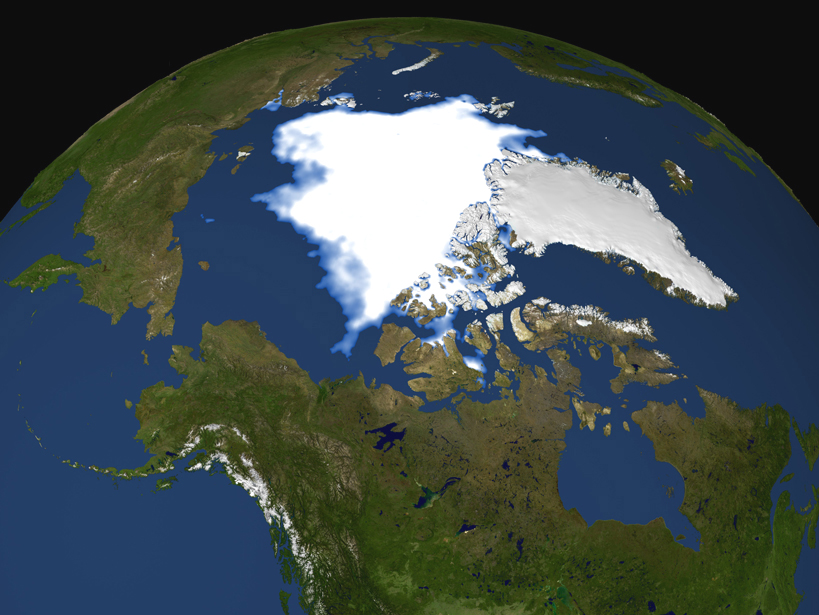In the face of a rapidly warming world, it is becoming increasingly important to climate science to understand the dynamics of the polar atmosphere-ocean-sea ice system and the mechanisms that connect the tropics with polar regions. Scientists met in June 2014 at the Lamont-Doherty Earth Observatory (LDEO) in New York to discuss the connections between the high and low latitudes in both hemispheres, along with outstanding problems. The workshop brought together 25 experts on tropical climate variability, polar climate variability, atmospheric dynamics, polar oceanography, climate and sea ice modeling, and paleoclimatology, as well as about 30 scientists from LDEO and the surrounding region.
Discussions centered on the degree of influence of the tropics on the higher latitudes and vice versa.
The workshop featured sessions on the tropics-pole connection in the Northern Hemisphere, in the Southern Hemisphere, and in paleorecords, as well as how the polar regions feed back to lower latitudes. Discussions centered on the degree of influence of the tropics on the higher latitudes and vice versa. Specific attention was paid to the roles of the atmosphere and ocean, depending on the timescale and time period, in both instrumental and paleoclimate records.
Participants also considered processes and patterns, such as the role of atmospheric jets, the Hadley and Ferrel cells, the Antarctic Dipole, the North Atlantic Oscillation, the Southern Annular Mode, the polar vortex, and chaos. The workshop showcased a mix of oral and poster presentations, with a focus on both observations and modeling.
A key aim of the workshop was to provide a setting to foster discussion and share advancements in tropical climate studies and polar processes. Direct communications among climate modelers, oceanographers, and atmospheric researchers will improve understanding of what the next generation of models can offer and their limitations in terms of investigating the tropical-polar connections.
The workshop also promoted interactions between senior and junior scientists and students, including undergraduates, on timely and critical climate topics. The midlatitude setting in the New York Palisades recalled the recognition by the Lenape Indians that the Hudson River flows both north and south (thanks to tidal forces), echoing the connection between the tropics and the poles.
The final program, the participant list, abstracts, and some presentations can be found on the workshop website. An expanded version of this meeting report also can be found on the website. Follow-up activities to this workshop included sessions at the American Geophysical Union 2014 Fall Meeting titled Extratropical and High-Latitude Storms, Teleconnections, and the Changing Polar Climate and an approved special issue in Journal of Climate, which will be published in 2015. Although the deadline for submitting a manuscript was around 1 March, interested parties should still contact Professor David Bromwich at Ohio State University ([email protected]) for details.
The workshop was funded by The Climate Center of LDEO and Goddard Institute for Space Studies (NASA) and the Director’s Office of LDEO. We thank Rob Gerston (NASA Goddard Space Flight Center) for providing the image’s data. This is Lamont-Doherty Earth Observatory contribution 7856.
—X. Yuan, Division of Ocean and Climate Physics, Lamont-Doherty Earth Observatory (LDEO), Palisades, N.Y.; M. A. Cane, Department of Earth and Environmental Sciences, Columbia University, New York, N.Y., and Division of Ocean and Climate Physics, LDEO; and M. R. Kaplan, Division of Geochemistry, LDEO, Palisades, N.Y.; email: [email protected]
Citation: Yuan, X., M. A. Cane, and M. R. Kaplan (2015), Connecting the tropics to polar regions, Eos, 96, doi:10.1029/2015EO027953. Published on 13 April 2015.
Text © 2015. The authors. CC BY-NC 3.0
Except where otherwise noted, images are subject to copyright. Any reuse without express permission from the copyright owner is prohibited.

